Jan 5 2018
A technique for developing hybrid thin-film materials, which are usually incredibly difficult to develop, has been devised by material scientists from Duke University. The process might prove be the pathway to futuristic light-emitting diodes, solar cells, and photodetectors.
 A closer look at the target of frozen solution that contains the building blocks for the solar cell material. (Photo credit: Duke University)
A closer look at the target of frozen solution that contains the building blocks for the solar cell material. (Photo credit: Duke University)
The technique has been described in detail in the ACS Energy Letters journal on December 22, 2017.
Perovskites are a category of materials that, when having the precise combination of elements, possess a crystalline structure. This results in them being best-suited for light-based applications. The potential of perovskites to absorb light and conduct its energy in an effective manner makes them the material of choice for scientists creating innovative kinds of solar cells, for instance.
At present, methylammonium lead iodide (MAPbI3) is the most common perovskite used for tapping solar energy; it can transform light into energy similar to commercially accessible solar panels. Moreover, it can achieve this using just a fragment of the material—a flake thinner by 100 times when compared to a normal silicon-based solar cell.
Methylammonium lead iodide is one among a handful of perovskites that could be synthesized by using standard industrial synthesis methods, despite the fact that it has problems with durability and scalability. However, if the capabilities of perovskites have to be really unlocked, innovative production techniques are required since the combination of inorganic and organic molecules in a complicated crystalline structure can be challenging to produce. Organic elements are specifically fragile; however, they play a vital role in the potential of the hybrid material to efficiently absorb and transmit light.
Methylammonium lead iodide has a very simple organic component, yet is a very high-performing light absorber. If we can find a new manufacturing approach that can build more complex molecular combinations, it will open new realms of chemistry for multifunctional materials.
David Mitzi, Professor of Mechanical Engineering and Materials Science
In the new research, Mitzi collaborated with Adrienne Stiff-Roberts, associate professor of electrical and computer engineering at Duke, to exhibit such a production technique, known as Resonant Infrared Matrix-Assisted Pulsed Laser Evaporation, or RIR-MAPLE, which was devised by Stiff-Roberts at Duke over the last decade.
The method was adapted from a technique known as MAPLE, invented in 1999, and involves freezing a solution including the perovskite molecular building blocks, and subsequently using a laser on the frozen block inside a vacuum chamber.
When a small portion of the frozen block (around the size of a golf ball dimple) is vaporized by the laser, the vapor progresses upward into a plume coating the bottom surface of any object hung above it; for example a component in a solar cell. When adequate quantity of the material is built up, the procedure is terminated and the end product is heated so that the molecules are crystallized and the thin film is set in place.
In the method adopted by Stiff-Roberts, the frequency of the laser is particularly adjusted according to the frozen solvent’s molecular bonds. This makes the solvent absorb a major portion of the energy, leaving the fragile organics undamaged when they move to the product surface.
“The RIR-MAPLE technology is extremely gentle on the organic components of the material, much more so than other laser-based techniques,” stated Stiff-Roberts. “That also makes it much more efficient, requiring only a small fraction of the organic materials to reach the same final product.”
Despite the fact that perovskite-based solar cells are not found in the market yet, a handful of companies are striving to commercialize methylammonium lead iodide and other closely associated materials. Although the materials developed in this research provide solar cell efficiencies higher than materials developed by using other laser-based techniques, they are still behind materials developed with conventional solution-based techniques.
However, Mitzi and Stiff-Roberts stated that this not their aim.
“While solution-based techniques can also be gentle on organics and can make some great hybrid photovoltaic materials, they can’t be used for more complex and poorly soluble organic molecules,” stated Stiff-Roberts.
“With this demonstration of the RIR-MAPLE technology, we hope to open a whole new world of materials to the solar cell industry,” Mitzi continues. “We also think these materials could be useful for other applications, such as light-emitting diodes, photodetectors and X-ray detectors.”
The National Science Foundation, Research Triangle MRSEC (DMR-1121107) supported the study. The study was performed in instrumentation laboratories, that are members of the North Carolina Research Triangle Nanotechnology Network (RTNN) supported by the National Science Foundation (ECCS-1542015) as part of the National Nanotechnology Coordinated Infrastructure (NNCI).